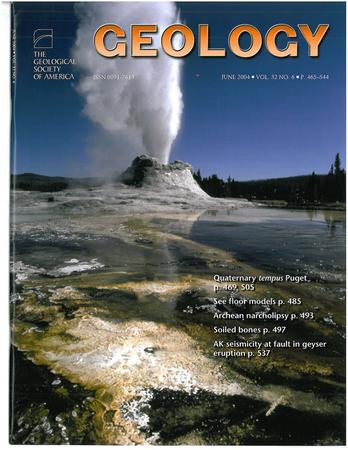阿曼斯图特盖碳酸盐岩中地幔样Sr同位素
IF 4.6
1区 地球科学
Q1 GEOLOGY
引用次数: 0
摘要
在低温期(720 - 635 Ma)两次,斯图亚特冰期和马里诺冰期,冰盖延伸到赤道纬度长达数百万年。这些极端气候被解释为记录了雪球气候状态,在这种状态下,地球上所有的海洋都被冰覆盖。在雪球地球时期,水循环会被缩短,硅酸盐的风化作用会大大减少。在这种情况下,深海化学应该通过洋中脊的热液交换向地幔值演化。具体来说,海水锶同位素(87Sr/86Sr)被预测为非放射性成因的地幔样值。然而,覆盖在冰川期冰川沉积物上的盖层碳酸盐产生的放射性87Sr/86Sr值与冰川期前海水的87Sr/86Sr值相似,这与雪球地球假说的中心地球化学预测不一致。在这里,我们报告了在阿曼卓法尔的Sturtian冰川沉积正上方的海相碳酸盐和自生重晶石中发现87Sr/86Sr值为0.7034。这些值要么记录了当地的非放射性源,要么记录了雪球地球以前未确定的深水值。如果这是一个全球性的信号,这些新的数据和地球化学模型支持一个极端的雪球地球情景,几乎完全被冰覆盖,并定义了地球历史上最大的海水地球化学扰动之一。本文章由计算机程序翻译,如有差异,请以英文原文为准。
Mantle-like Sr isotopes in a Sturtian cap carbonate in Oman
Twice in the Cryogenian Period (720−635 Ma), during the Sturtian and Marinoan glaciations, ice sheets extended to equatorial latitudes for millions of years. These climate extremes have been interpreted to record the Snowball climate state, in which all of Earth’s oceans were covered with ice. During a Snowball Earth, the hydrological cycle would have been curtailed and silicate weathering greatly reduced. In this scenario, deep ocean chemistry should have evolved toward mantle values through hydrothermal exchange at mid-ocean ridges. Specifically, seawater strontium isotopes (87Sr/86Sr) are predicted to exhibit unradiogenic mantle-like values. However, cap carbonates that overlie the Cryogenian glacial deposits have yielded radiogenic 87Sr/86Sr values similar to those of seawater prior to glaciation, inconsistent with the central geochemical prediction of the Snowball Earth hypothesis. Here we report the discovery of 87Sr/86Sr values of 0.7034 in marine carbonate and authigenic barite that rest directly above Sturtian glacial deposits in Dhofar, Oman. These values record either a local unradiogenic source or Snowball Earth deep-water values that have not been previously identified. If it is a global signal, these new data and geochemical modeling support an extreme Snowball Earth scenario with near-complete ice cover and define one of the largest geochemical perturbations to seawater in Earth history.
求助全文
通过发布文献求助,成功后即可免费获取论文全文。
去求助
来源期刊

Geology
地学-地质学
CiteScore
10.00
自引率
3.40%
发文量
228
审稿时长
6.2 months
期刊介绍:
Published since 1973, Geology features rapid publication of about 23 refereed short (four-page) papers each month. Articles cover all earth-science disciplines and include new investigations and provocative topics. Professional geologists and university-level students in the earth sciences use this widely read journal to keep up with scientific research trends. The online forum section facilitates author-reader dialog. Includes color and occasional large-format illustrations on oversized loose inserts.
 求助内容:
求助内容: 应助结果提醒方式:
应助结果提醒方式:


